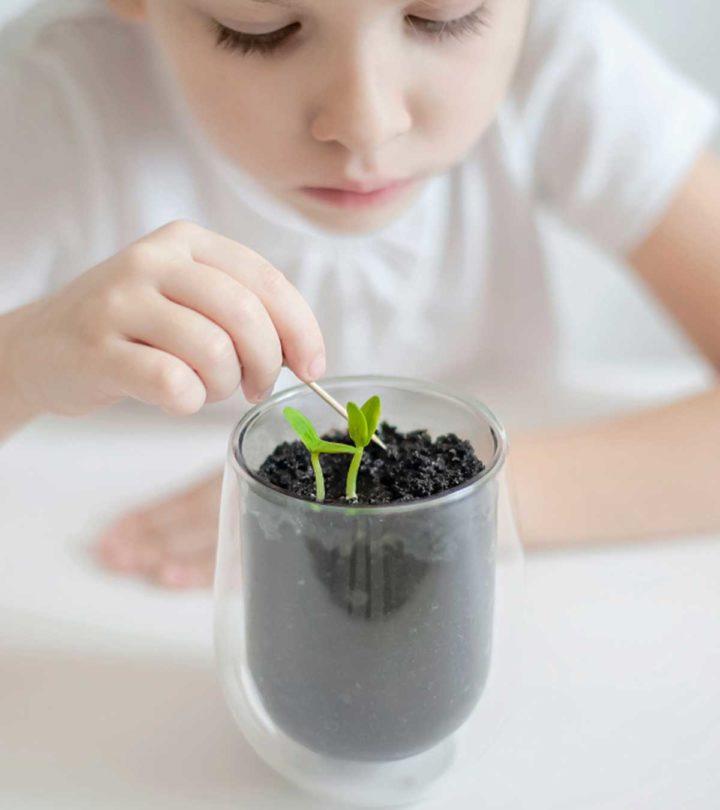
Image: Midjourney/ MomJunction Design Team
Science takes a child to the magical world of animals, the environment, and plants. We present you with some science quiz questions for kids that will pique their curiosity about the subject. A science quiz is an effective way to generate curiosity in your child and make the learning a fun activity. Plunge into this post for a fascinating list of science questions with answers to make learning the subject engaging and entertaining.
65 Science Quiz Questions and Answers For kids
Science Quiz For Grade 1
1. Which animal lays eggs?
a. Dog
b. Cat
c. Duck
d. Sheep
Answer:
Duck
2. A male cow is called?
a. Ox
b. Dog
c. Sheep
d. Monkey
Answer:
Ox
3. All animals need food, air, and ____ to survive.
a. House
b. Water
c. Chocolate
d. Fruits
Answer:
Water
Image: Created with Dall·E
4. Which one is a fur-bearing animal?
a. Hen
b. Crocodile
c. Tortoise
d. Cat
Answer:
Cat
5. What is Earth’s only natural satellite?
a. Sun
b. Mars
c. Venus
d. Moon
Answer:
Moon
6. The tree has a branch filled with green _____.
a. Hair
b. Root
c. Leaves
d. Trunk
Answer:
Leaves
7. What part of the body helps you move?
a. Eyes
b. Lungs
c. Pancreas
d. Muscles
Answer:
Muscles
8. The two holes of the nose are called?
a. Eyelids
b. Nostrils
c. Nails
d. Hair
Answer:
Nostrils
9. What star shines in the day and provides light?
a. Moon
b. Venus
c. Mars
d. Sun
Answer:
Sun
10. Legs have feet and arms have ___.
a. Ankles
b. Pelvis
c. Hands
d. Skull
Answer:
Hands
11. Which organ covers the entire body and protects it?
a. Liver
b. Heart
c. Skin
d. Brain
Answer:
Skin
12. Which shape is a round?
a. Rectangle
b. Circle
c. Square
d. Triangle
Answer:
Circle
13. Who invented the first functional telephone?
Image: IStock
a. Albert Einstein
b. Nikola Tesla
c. Thomas Alva Edison
d. Alexander Graham Bell
Answer:
Alexander Graham Bell
 Trivia
Trivia14. What is the young one of a cow called?
a. Puppy
b. Kitten
c. Calf
d. Baby
Answer:
Calf
15. Dark rain clouds can give out lightning and ____.
a. Thunder
b. Snow
c. Sunlight
d. Wind
Answer:
Thunder
16. Your hands have four fingers and a ____.
a. Knee
b. Ankle
c. Elbow
d. Thumb
Answer:
Thumb
17. Which part of the bird lets it fly high in the sky?
a. Beak
b. Feet
c. Wings
d. Claws
Answer:
Wings
Science Quiz For Grades 2 & 3
18. Animals that suckle their young one are called ____.
a. Reptiles
b. Birds
c. Amphibians
d. Mammals
Answer:
Mammals
19. What part of the plant conducts photosynthesis?
a. Branch
b. Leaf
c. Root
d. Trunk
Answer:
Leaf
20. What is the boiling point of water?
a. 25°C
b. 50°C
c. 75°C
d. 100°C
Answer:
100°C
21. Which is the largest land animal?
a. Lion
b. Tiger
c. Elephant
d. Rhinoceros
Answer:
Elephant
22. ____ helps pump blood through the entire body.
a. Lungs
b. Kidneys
c. Heart
d. Brain
Answer:
Heart
23. How does a dog express happiness?
a. Twitching ears
b. Moving head
c. Closing eyes
d. Wagging tail
Answer:
Wagging tail
24. What are the three states of matter?
Answer: Solid, Liquid, and Gas
25. Frog is a reptile or amphibian?
Answer: Amphibian
26. If one boils water it will convert into ____.
Image: IStock
a. Mist
b. Steam
c. Clouds
d. Snow
Answer:
Steam
27. When you push something, you apply ____.
a. Force
b. Acceleration
c. Mass
d. Compression
Answer:
Force
28. Which group of animals have scales?
a. Mammals
b. Amphibians
c. Reptiles
Answer:
Reptiles
29. Where does our food collect after we chew and swallow it?
a. Small intestine
b. Large intestine
c. Stomach
d. Liver
Answer:
Stomach
30. Which material from the following has the highest transparency?
a. Paper
b. Wood
c. Metal
d. Glass
Answer:
Glass
31. Which animal from the below list is best adapted to the desert?
a. Tiger
b. Cheetah
c. Camel
d. Deer
Answer:
Camel
32. What part of the skeletal system protects the brain?
a. Spine
b. Thigh
c. Pelvis
d. Skull
Answer:
Skull
33. What is the name of a frog’s young one?
a. Infant
b. Puppy
c. Calf
d. Tadpole
Answer:
Tadpole
34. Which pigment gives the leaves its green color?
Answer: Chlorophyll
Science Quiz For Grades 4, 5, 6, & 7
35. What tissue connects muscles to bones?
a. Skin
b. Blood vessels
c. Fat
d. Tendon
Answer:
Tendon
36. Which nutrient plays an essential role in muscle-building?
a. Protein
b. Carbohydrate
c. Iron
d. Fat
Answer:
Protein
37. Plants need which gas to perform photosynthesis?
a. Hydrogen
b. Carbon monoxide
c. Carbon dioxide
d. Oxygen
Answer:
Carbon dioxide
38. Which scientist proposed the three laws of motion?
a. Isaac Newton
b. Thomas Alva Edison
c. Albert Einstein
d. Stephen Hawking
Answer:Isaac Newton39. Earth is surrounded by layers of gasses collectively called the _____.
Image: IStock
a. Hydrosphere
b. Stratosphere
c. Atmosphere
d. Ozone layer
Answer:
Atmosphere
40. Which system of the body controls the senses?
a. Circulatory system
b. Digestive system
c. Nervous system
d. Skeletal system
Answer:
Nervous system
41. Which is the largest animal on earth?
a. Shark
b. Elephant
c. Blue whale
d. Giraffe
Answer:
Blue whale
 Did you know?
Did you know?42. Similar body cells group together to form a ___.
a. Organ
b. Tissue
c. Blood vessels
d. Joints
Answer:
Tissue
43. What energy emerges from motion?
a. Potential energy
b. Electrical energy
c. Kinetic energy
d. Gravitational energy
Answer:
Kinetic energy
44. Which is the strongest sense in a dog?
a. Touch
b. Hearing
c. Smell
d. Taste
Answer:
Smell
45. The standard unit of measurement for energy is ____.
a. Newton
b. Ampere
c. Watt
d. Joule
Answer:
Joule
46. Which biologist proposed the theory of evolution through natural selection?
a. Charles Darwin
b. Stephen Hawking
c. Francesco Redi
d. Alexander Fleming
Answer:
Charles Darwin
47. What are animals, which eat both plants and animals, called?
a. Herbivores
b. Insectivores
c. Carnivores
d. Omnivores
Answer:
Omnivores
48. The outward force, away from the center, felt by an object in circular motion is ___.
a. Centripetal force
b. Circular force
c. Centrifugal forces
d. Elastic force
Answer:
Centrifugal force
49. What type of energy eventually depletes?
a. Kinetic energy
b. Non-renewable energy
c. Gravitational energy
d. Renewable energy
Answer:
Non-renewable energy
50. A single piece of coiled DNA is called ____.
a. Nucleus
b. Ribosome
c. Cytoplasm
d. Chromosome
Answer:
Chromosome
51. Yeast is a type of ____.
a. Plant
b. Animal
c. Bacterium
d. Fungus
Answer:
Fungus
52. Which is the closest planet to the sun?
Image: IStock
a. Venus
b. Mars
c. Mercury
d. Earth
Answer:
Mercury
Science quiz for grades 8, 9, & 10
53. “For every action, there is an equal and opposite reaction.” It is which of Newton’s law of motion?
a. First Law
b. Second Law
c. Third Law
Answer:
Third Law
54.Which cell organelle is also called the powerhouse of the cell?
a. Ribosome
b. Endoplasmic reticulum
c. Cytoplasm
d. Mitochondria
Answer:
Mitochondria
55. The bending of light through a glass prism is called ____.
a. Reflection
b. Refraction
c. Diffraction
d. Absorption
Answer:
Refraction
56. A lion is most closely related to which of the following animals?
a. Dog
b. Raccoon
c. Wolf
d. Leopard
Answer:
Leopard
 Trivia
Trivia57. Newtons is the unit of force or energy?
Answer: Force
58. Diabetes happens because of problems in which organ of the body?
a. Liver
b. Heart
c. Pancreas
d. Kidneys
Answer:
Pancreas
59. Which of the following is NOT a form of carbon?
a. Diamond
b. Graphite
c. Amorphous carbon
d. Ferrite
Answer:
Ferrite
60. Sweet potato is an example of a modified _____.
a. Leaf
b. Root
c. Stem
d. Branch
Answers:
Root
61. Medicine that is given to fight bacteria but not viruses?
Answer: Antibiotic
62. Earthquakes are caused due to movements of ______.
Answer: Tectonic plates
63. An acidic liquid will have a ___ pH.
Answer: Low
64. Which is the lightest element in the periodic table?
a. Helium
b. Carbon
c. Nitrogen
d. Hydrogen
Answer:
Hydrogen
65. What elements are the most common in the human body?
Image: IStock
a. Sulfur, sodium, magnesium
b. Phosphorus, nitrogen, calcium
c. Copper, zinc, selenium
d. Oxygen, carbon, hydrogen
Answer:
Oxygen, carbon, hydrogen
Frequently Asked Questions
1. What is a science quiz bee?
The International Science Bee is a science-themed academic quiz competition in America for students from Elementary School through High School.
2. How does the science bee work?
Science bee is a buzzer-based competition consisting of qualifying stages, regional finals, and divisional championships.
3. What are the benefits of quizzes?
Quizzes make students thoroughly read the study material. They can gain the right attitude for learning, feel more confident, their curiosity is satisfied in an exciting manner, and they get an opportunity to brush up their knowledge.
Most children love science because it explains the interesting things happening around them. It also helps them explore the world and develop life skills. Introducing them to more facts and interesting branches of science such as astronomy, oceanography, botany, ornithology, paleontology, and herpetology, can make them passionate about science and help them dive deep into it. Organizing a science quiz is an excellent way to engage children and improve their learning while having fun. Go through the interesting science quiz questions for kids and let your child answer them as you ask questions. You can therefore enjoy a fun-filled quiz session.
Infographic: Biological Science Quiz Questions For Kids
Biology is a branch of science that teaches us about living organisms. Quizzing can be an excellent way to make biology lessons more engaging for kids. See the infographic below to find some easy-to-hard questions to ask them on a casual day and instill interest in the subject. Illustration: Momjunction Design Team
Key Pointers
- Science is essential for children because it nurtures their natural curiosity about the world.
- Science quiz questions can be categorized by grade level.
- Ensuring that the content is age-appropriate and matches the child’s learning stage.
- The questions can cover many scientific topics, including biology, physics, chemistry, earth science, etc.
References
- Difference between Lion and Leopard
http://www.differencebetween.info/difference-between-lion-and-leopard - Interesting Facts About Telephones – The Fact File
https://thefactfile.org/telephone-facts/ - Blue Whale Facts – Whale Facts
https://www.whalefacts.org/blue-whale-facts/
Read full bio of Dr. Neha Mehta
Read full bio of Deepa Thomas
Read full bio of Kavita Kankani


























